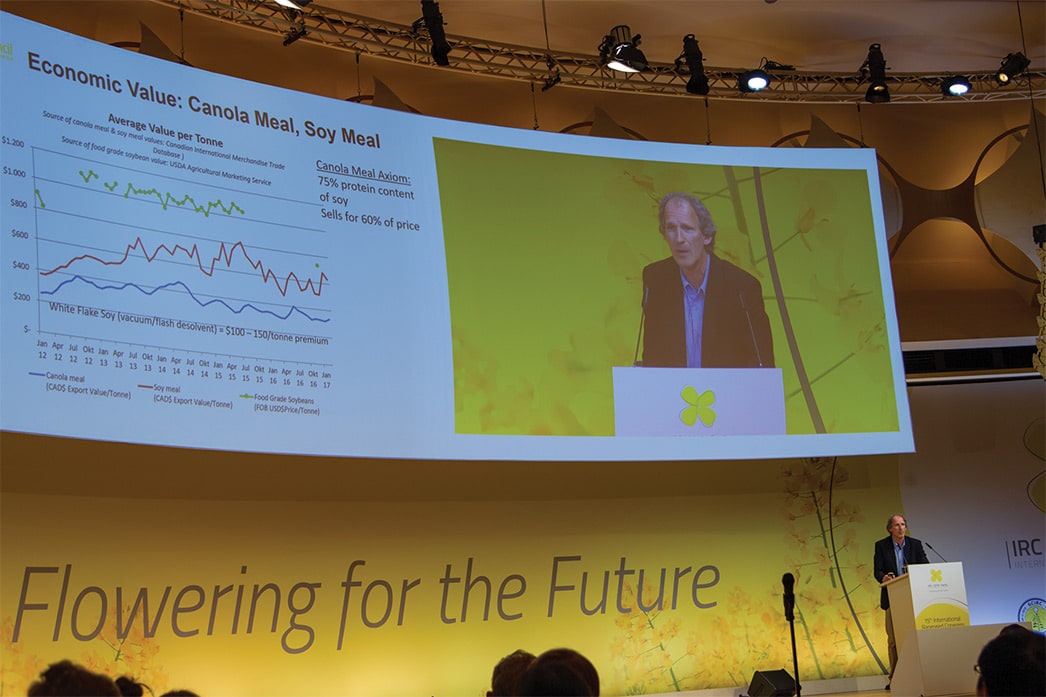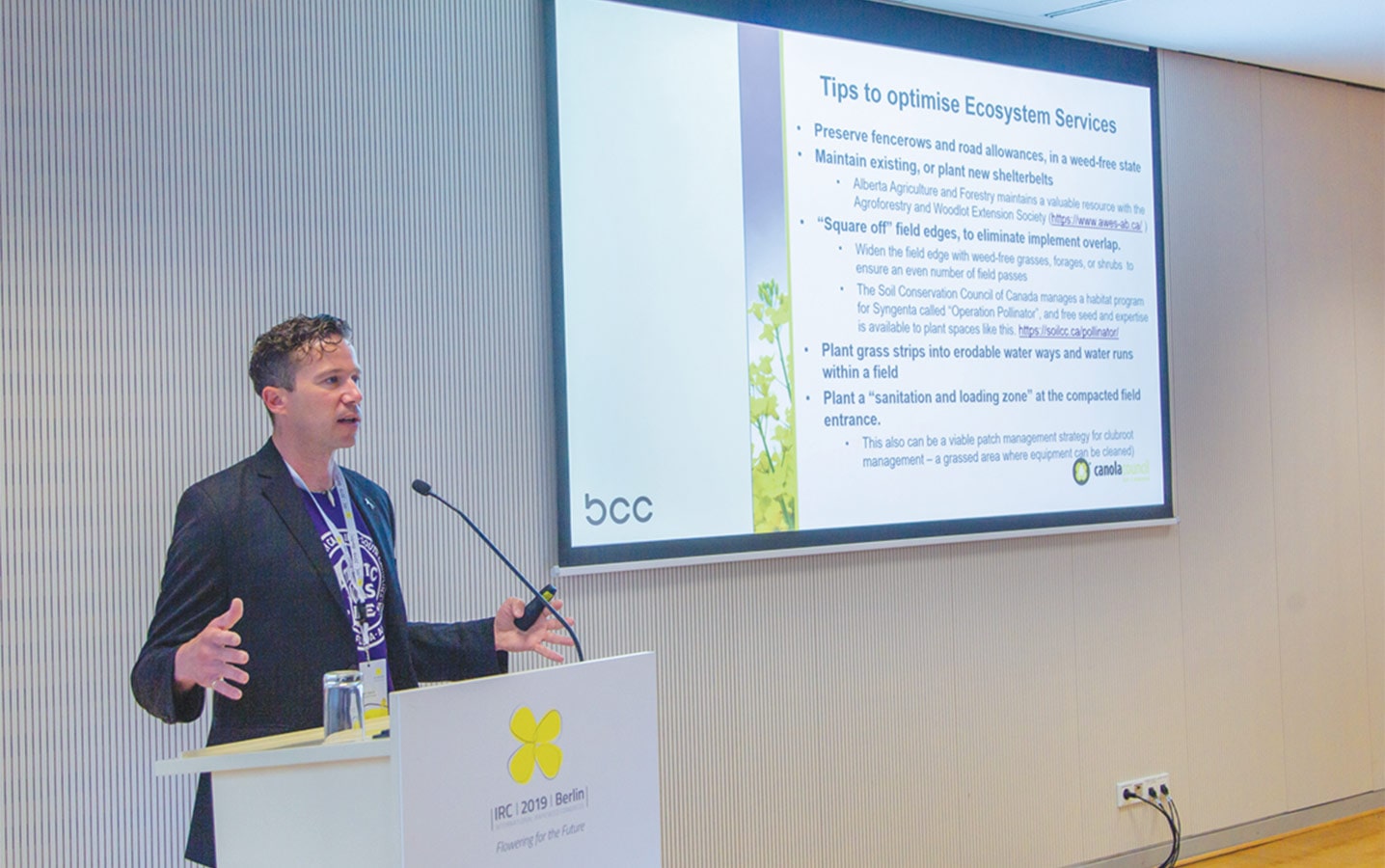Take-home Messages from IRC in Berlin
World-class researchers, economists, agronomists and growers meet every four years at the International Rapeseed Congress to keep up-to-date on the latest information on this crop. In this article, the five CCC staff who attended the congress share discoveries that will help Canada’s canola industry achieve its strategic plan to produce and market 26 million tonnes of canola per year by 2025.
Why our best management practices must be followed
By Curtis Rempel
Many speakers opened with the message that oilseed rape planting and yields are declining in the European Union (EU). Reasons cited were the ban on neonicotinoid insecticides, specifically seed treatment use, and the very recent ban in Austria (and impending ban in other countries) on fall-applied nitrogen (N) fertilizer due to high levels of nitrates in groundwater. The takeaway for our value chain is that we need to continue advocating for neonicotinoids based upon the economic advantages and non-target safety when used in responsible IPM programs. As producers and industry we need to implement vegetative buffer zones or filter strips around sensitive areas (i.e., wetlands) and minimize soil disturbance prior to planting within two or three metres of wetlands and sensitive habitat.
Nitrogen stewardship is also critical and without best management practices (BMPs) based on 4R principles, nitrogen use could also be restricted in Canada or our export of seed produced using N fertilizer could be restricted.
Several speakers highlighted the importance for canola (or oilseed rape) in crop rotations, as canola has a deep root that can break up sub-soil hard pan layers. This allows for better water penetration, sequesters significant amounts of atmospheric carbon, promotes soil microbes beneficial for cereals and potatoes, suppresses diseases of potato, provides humus through roots and contributes significantly to soil organic matter due to straw production.
The key message for growers and commercial agronomists is that canola in rotation not only drives profit, but also helps reduce disease and manage nutrients for other crops grown on the farm.
In order to stop decline in planted acres due to restriction on fertilizer and crop protection products, emphasis is required for breeding and agronomy for biological-based innovation. The CCC will continue to advocate for this on behalf of the canola value chain in Canada.
Another major benefit to attending IRC was to identify opportunities for market growth for Canadian canola. Domestic and global demand for plant-based protein is increasing, and Canada’s canola industry needs to find ways to break into that market. The Canadian canola industry contributes approximately $26 billion to the economy annually but only $600 million of this accrues from protein meal production and utilization. The soybean industry, which already dominates the market, continues to invest significantly. New canola genetic breeding lines being developed in Canada can offer some protein benefit. Average amino acid content for alanine, cysteine, glycine and methionine (amino acids needed for human health) in these Canadian canola breeding lines exceeds the national mean amino acid levels of U.S. soy meal. These new genetic breeding lines have been developed in part with producer levy and taxpayers dollars for industry.
Opportunities discussed at IRC included taurine (tau) and biodegradable industrial lubricants. Tau is an amino sulphonic acid required for aquafeed, pet food, infant formula and energy drinks. Plants do not make this; it is found only in meat, dairy and human milk. Canola tau could be used as a safe, fortified plant protein-based ingredient for aquafeed or pet food or a purified ingredient concentrate in food and energy drinks. Biodegradable industrial lubricants are also highly desirable by industry for “green” chemistry. Canola specialty lines with erucic acid levels of 58-60 per cent would have the high heat stability for use in industrial motors, drilling fluid, and other high margin uses as a biodegradable, renewable substitute for mineral oil.
*For Curtis Rempel’s full report, including much more detail on new market opportunities in protein and specialty oils, go to the “Editor’s Updates” section at canoladigest.ca.

Global concerns for canola/rapeseed could rub off on Canada
By Clinton Jurke
I attended the “Global Rapeseed Production Workshop”, which was part of the Congress agenda. Participants in the workshop looked for trends and issues in growing canola/rapeseed around the world. I discovered that most regions have very serious insect, disease, climate change and regulatory issues. Canada’s production issues are relatively minor in comparison. Canada and China are the only canola producing regions where yield is still increasing. Europe and Australia are flat, and this is due to insects and diseases. Insects and diseases are becoming increasingly resistant to the pesticides being used to control them in all regions. Given the regulatory challenges around pest control products and genetic tools, there are very real concerns about reduction in investment in this crop.
Genetically, Brassica napus allows for a lot of advancement and improvement. While it has very limited genetic diversity compared to its parents, B. rapa and B. oleracea, B. napus overcomes this speciation bottleneck with homeologous pairing of its chromosomes, which creates new genetic variations not found in either parent. An example is quantitative blackleg resistance that does not exist in B. oleracea and B. rapa. B. napus appears to have a plastic genome which allows its success despite its bottleneck beginnings.
Tips to ‘future-proof’ pest insect control practices
By Gregory Sekulic
Globally, regulatory agencies are tightening restrictions on use rates and patterns for pest control products. None more so than the EU, which has a de facto moratorium on new product registration and is cancelling registrations for existing products.
The result is that EU farmers are making more applications annually using a narrowing range of active ingredients, which further increases selection pressure for insect resistance. It is clear that producers need to decrease reliance on chemistry, and focus much more attention on integrated pest management (IPM) and natural controls.
Fortunately, a tremendous amount of research effort is underway in this arena, with a substantial cross section displayed and discussed at the “Future-proofing insect control in a world with declining insecticidal options” workshop.
European research supplements and complements North American work on the role natural enemies can play in pest management. For example, many of the same species can be found in Canada as the U.K., such as the rove beetle Aleochara bilineata, an important consumer of cabbage root maggot, and the Trichomalus perfectus wasp, a voracious parasite of cabbage seedpod weevil.
Of paramount importance in encouraging populations of these parasites and predators is in maintaining a home and habitat for them to live unencumbered. Natural, undisturbed spaces and zero tillage work together to provide refuge for many of these species, which are sufficiently widespread and abundant across Europe and North America to be of substantial economic importance for biocontrol of pests, and reduce the need for insecticide use.
Fungicide seed treatments for blackleg show promise
“Blackleg genomics continues to be the primary focus in management, but promising new work on fungicide seed treatments was also presented. These fungicides will provide producers with a new tool to manage the disease early.”
By Justine Cornelsen
Blackleg is a global disease of concern for canola. Research groups from around the world have teamed up to share their findings to better understand the Brassica napus- Leptosphaeria maculans (canola-
blackleg) pathosystem. While at IRC, I attended a blackleg workshop and two blackleg sessions, which allowed the research community to connect and advance their understanding of novel blackleg resistance genes. Many of the genes are now being cloned and introgressed into Brassica napus germplasm with Canadian researchers leading the research. The diversity in resistance genes will provide producers with the opportunity to match the specific blackleg profile within their fields.
Learning about management techniques and stewardship of resistance sources from canola producing regions helps establish new tactics to deploy here in Canada. This will help us stay one step ahead of this pest.
Blackleg genomics continues to be the primary focus in management, but promising new work on fungicide seed treatments was also presented. These fungicides will provide producers with a new tool to manage the disease early. These products will provide early protection that will help minimize the risk of a blackleg infection at that critical infection stage where the majority of the yield loss from the disease is seen in Canada. Complex pests need diverse management plans!
Insect pests and management challenges
“I got a chance to hear about specific management strategies and thresholds for pollen beetle and cabbage stem beetle, which are common pests of oilseed rape in the United Kingdom. While these treatments are not of immediate need in Canada because these insects are not pests yet, the process used to develop these thresholds was valuable.”
By Keith Gabert
Managing crops to avoid insect pests and maintaining access to insecticides were frequent undercurrents in the insect pest sessions I attended at IRC. Insecticide resistance in a number of key pests is challenging growers’ ability to manage and grow oilseed rape in the EU specifically. The regulatory environment tends to limit insecticide options, leading to a quicker development of pests that are resistant to insecticides.
Getting plants to produce biologically-active compounds that deter pollen beetle, cabbage root fly or flea beetles might work, but producing canola-quality breeding material with these traits remains a distant possibility.
Crop rotation and insecticide rotation within that crop rotation is critical to a Canadian grower’s success.
I got a chance to hear about specific management strategies and thresholds for pollen beetle and cabbage stem beetle, which are common pests of oilseed rape in the United Kingdom. While these treatments are not of immediate need in Canada because these insects are not pests yet, the process used to develop these thresholds was valuable. Some of the techniques used include monitoring insect populations with ground-placed rings and traps to determine existing versus migratory populations. Tracking parasitism rates and the rise of insecticide resistance are valuable discussions and skills to understand as a Canadian agronomist. Cutting edge technology like the LIDAR (low intensity radar), which was described at IRC, could be easily adapted to Western Canada.
Researchers and industry presenting and attending IRC understand their particular local production issues very well, but are forward-thinking enough to realize that collaboration and networking at industry events like IRC can be a great source of information and contacts. For a Canola Council of Canada agronomy specialist like me, the ability to adapt this type of information or processes to issues at home or research projects proposed for funding is invaluable.
Effective insect pest management and evaluating and predicting future threats is of critical importance for the Canadian canola industry. With relatively few insect pests affecting our crop and a comparatively harsh climate, it is to our growers’ advantage to limit or eliminate the potential for additional insect pests to become established.
Maintaining access to seed treatment and foliar insecticides for what is infrequent use by global standards will assist in maintaining our competitive advantage in growing our crop.





